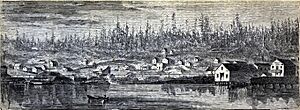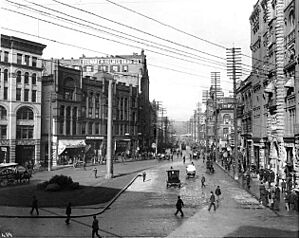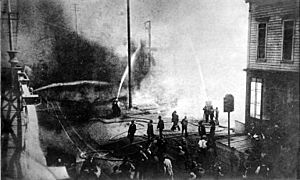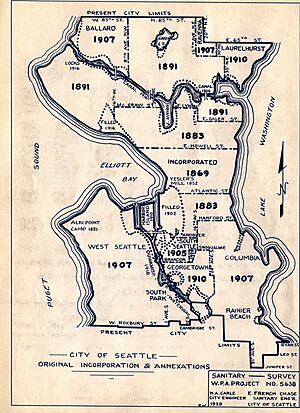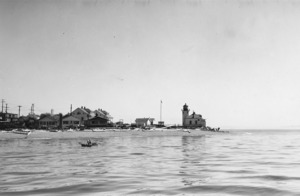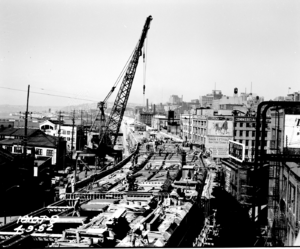History of Seattle facts for kids
This article tells the story of Seattle, Washington, a big port city in the Pacific Northwest of the United States.
Seattle has often gone through periods of rapid growth (called "booms") followed by tough times (called "busts"). But after each tough time, the city usually rebuilt and became even stronger. Here are some of these cycles:
- A big boom in the lumber industry, which led to the creation of a beautiful park system designed by Frederick Law Olmsted.
- The Klondike Gold Rush started in 1896 and brought a huge boom to Seattle in July 1897. This helped Seattle recover from a tough economic time.
- A shipbuilding boom during World War I, which ended quickly after the war. This was followed by a city development plan by Virgil Bogue that was never used.
- The Boeing airplane company caused a big boom, leading to lots of new buildings and roads.
- More recently, a boom driven by technology companies like Microsoft, Amazon.com, and others.
Contents
Early Days of Seattle
The area where Seattle is today has been lived in for at least 4,000 years, since the end of the last Ice Age. In the mid-1850s, Coast Salish groups like the Duwamish and Suquamish lived in about 13 villages within what are now Seattle's city limits. One village site, abandoned around 1800, shows people lived there continuously since the 6th century. Chief Seattle's birthplace was also in this area.
George Vancouver was the first European explorer to visit the Seattle area in May 1792. He was charting the Pacific Northwest.
The founding of Seattle is usually marked by the arrival of the Denny Party on September 25, 1851. However, another group, led by Luther Collins, started a farming settlement in what is now Georgetown on September 27, 1851. The Denny Party first settled at Alki Point in West Seattle. In April 1852, Arthur A. Denny moved to a better spot on Elliott Bay, which is now part of Downtown Seattle. David Swinson "Doc" Maynard also settled land nearby.
In its early years, Seattle's main business was the timber industry. Huge, ancient trees covered much of the area. Henry Yesler brought the first steam sawmill, making Seattle a leader in lumber.
Charlie Terry, an early settler, helped develop Seattle by acquiring land and donating some for the University of Washington. He also helped establish city services. The logging town quickly grew into a small city. Most of the first businesses were in Maynard's area.
Relations with the local Native American people were sometimes difficult. There was a conflict called the Battle of Seattle on January 25, 1856.
Seattle officially became a town on January 14, 1865. This first charter was canceled in 1867, but Seattle was re-incorporated on December 2, 1869. At these times, the population was about 350 and 1,000 people.
In 1867, a French Canadian Catholic priest named Francis X. Prefontaine arrived. He built Seattle's first Catholic church in 1869, mostly by himself, after raising money through fairs.
Railroad and City Growth
On July 14, 1873, the Northern Pacific Railway announced it would end its transcontinental railroad in Tacoma, not Seattle. The railroad owners wanted to buy land cheaply around their chosen spot.
Seattle tried hard to get its own railroad. The Great Northern Railway finally reached Seattle in 1884, helping Seattle compete for trade. A major passenger train station arrived in 1906.
In this era, Seattle was a growing but challenging place. While it had newspapers and telephones, basic services like indoor plumbing were rare. Streets were often muddy and full of holes.
Workers began forming unions to improve their conditions. Printers formed a union in 1882, followed by dockworkers, cigarmakers, and others.
In 1885-1886, some white settlers, complaining about competition for jobs, forced Chinese laborers to leave Seattle and other Northwest cities.
Women played an important role in making Seattle a more organized and "civilized" city.
By the 1880s, Seattle gained its first streetcar and cable car, ferry service, and a YMCA gym. The city also started developing a road system.
Seattle grew much faster than Tacoma between 1880 and 1890. Seattle became a center for services and manufactured goods, while Tacoma remained more of a "company town" tied to one industry.
The Great Fire
A major event in early Seattle was the Great Seattle Fire on June 6, 1889. It started from a glue pot and burned 29 city blocks, destroying almost all the wooden buildings and most of the business district and docks. Other cities in Washington also had big fires that summer.
Thanks to quick financial help, Seattle rebuilt incredibly fast. New rules meant downtown buildings had to be made of brick and stone instead of wood. In just one year after the fire, the city's population grew from 25,000 to 40,000, mainly because of all the construction jobs.
The Klondike Gold Rush
The biggest growth period for Seattle happened during the Klondike Gold Rush. Before this, Seattle and the rest of the country were struggling economically. Gold was found in Canada's Klondike region in August 1896. Almost a year later, on July 17, 1897, a ship called the Portland arrived in Seattle with a "ton of gold." This event, helped by a clever publicity campaign, started the Klondike gold rush. Seattle became the main supply center and starting point for people traveling to the gold fields in Alaska and the Yukon. This rush ended Seattle's economic problems overnight. People said, "The miners mined the gold. Seattle mined the miners."
Beginning of the 20th Century
Seattle Becomes a Leader: 1900–1915
The gold rush brought many new people to Seattle. Many of Seattle's neighborhoods began around this time. Downtown Seattle was very busy, and as people moved to new neighborhoods, new immigrants took their places in the city center.
As the city grew, streetcars helped people travel to new areas outside downtown.
City engineer R.H. Thomson led a huge project to level Seattle's steep hills. Dirt from this project was used to create the current waterfront and build Harbor Island at the mouth of the Duwamish River.
Other big changes to Seattle's landscape included reshaping Pioneer Square and the International District. The Lake Washington Ship Canal, built from 1911 to 1917, included new waterways and bridges. This project also caused the level of Lake Washington to drop, making the Black River dry up and turning Seward Island into Seward Park.
Even with all this expansion, the city didn't have specific zones for different types of buildings, so homes and businesses were mixed together.
At the same time, city planners started creating parks and boulevards based on a plan by the Olmsted Firm. This plan gave Seattle many parks and miles of tree-lined streets, which still give the city its special feel today.
Seattle, once a wilderness, was becoming a major city. The Seattle Symphony was founded in 1903. Popular entertainment also grew, with famous theater owners like Alexander Pantages and John Considine based in Seattle.
As a major port, Seattle relied heavily on its waterfront. Before 1911, it was a mix of private rail lines and docks. City leaders improved the system by building a port owned and operated by the local government. This efficient new system helped Seattle grow after 1945 and become a leader in shipping goods to Asia.
Seattle celebrated its growth with the Alaska–Yukon–Pacific Exposition in 1909. But this rapid growth also made people question the social order. Some people, called "progressives," wanted "good government" and challenged the power of big business leaders.
Religion was less powerful in Seattle than in eastern cities, but the Protestant Social Gospel movement had a national leader in Rev. Mark A. Matthews of Seattle's First Presbyterian Church. He was a reformer who worked to improve the community, building a model church with night schools, job help, and clinics.
World War I and After
In 1910, Seattle voters approved a plan for city development called the Bogue plan. This plan included a large civic center, a rapid transit system, and a huge expansion of parks, even turning Mercer Island into parkland. However, the plan was never put into action because some people thought it was too expensive, and others felt it would only benefit the wealthy.
During the 1910s, Seattle's growth was mostly in lumber and shipping. World War I increased trade in the Pacific Ocean and caused a boom in shipbuilding. But when the war ended, the economy crashed because the government stopped buying boats, and there were no new industries to replace the lost business. Seattle stopped growing as fast as it had been.
After the war, there was a big workers' strike in Western Washington. In 1919, a disagreement over lower wages for waterfront workers grew into the Seattle General Strike. Seattle's mayor, Ole Hanson, became famous for opposing the strike.
Even though Seattle's economy slowed, it started to become an arts center in the 1920s. The Frye and Henry families displayed their art collections, which later became the Frye Art Museum and Henry Art Gallery. Artists like Mark Tobey and Morris Graves became well-known. The city's jazz scene also grew, launching the careers of famous musicians like Ray Charles and Quincy Jones.
In 1924, Seattle's Sand Point Airfield was the end point of the first aerial circumnavigation (flying around the world). This historic flight helped make Sand Point a Naval Air Station.
The Great Depression hit Seattle hard. For example, in 1930, Seattle issued 2,538 permits for new homes, but only 361 in 1932. During the 1934 West Coast waterfront strike, shipping was greatly affected.
WWII and the Boeing Era: 1945 - 1970
From World War II until 1970, Seattle had a long period of economic growth. The Boeing company was hiring many people, and the economy was strong.
The Boeing airplane company started from William "Bill" Boeing's boat business and his interest in flying. During World War I, Boeing grew to employ about four thousand people. Between the wars, the company struggled and even made furniture. But when World War II began, the government needed thousands of planes, and Boeing was ready to build them. Boeing became by far the largest employer in Seattle.
When the war ended, the military stopped ordering bombers, and Boeing factories closed. About 70,000 people lost their jobs. It seemed like Seattle didn't gain much from the wartime boom. However, this tough time ended when jet aircraft became popular, and Boeing became the world's leading maker of commercial passenger planes.
At the same time, new freeways were built to handle the growth. Many suburbs east of Lake Washington and to the north grew during the Boeing boom, as did Interstate Highways like I-5 and I-90. I-5 cut off Downtown Seattle from areas like Capitol Hill. Later, Freeway Park was built over I-5 in 1976 to reconnect these areas.
All this growth led to more pollution in the lakes and rivers. Also, the constant need for more roads caused terrible traffic. People like Jim Ellis formed the Metropolitan Problems Committee, or METRO, to manage and plan the growing area. METRO eventually focused on sewage treatment and was later merged into the King County government.
During this time, Seattle tried to improve its downtown by hosting the Century 21 Exposition, the 1962 World's Fair. The fair had a futuristic science theme and left behind a civic center, now called Seattle Center. This includes arts buildings, the Pacific Science Center, and the famous Space Needle.
A demonstration monorail line was built for the fair and later given to the city. It's now mainly a tourist attraction. The World's Fair helped re-energize downtown Seattle and was a big success.
After the war, the University of Washington also grew and became a stronger university.
The Boeing Bust
Boeing and the Seattle area faced a very tough time after 1969. Military spending for the Vietnam War decreased, the space program was slowing down, and there was an economic recession. Boeing also had a lot of debt from building the 747 airliner.
Boeing's Commercial Airplane Group, its largest division, went from 83,700 employees in 1968 to only 20,750 in 1971. For every Boeing employee who lost their job, at least one other job was lost. Unemployment in Seattle rose to 14%, the highest in the United States. Many people moved out of the city. A famous billboard near the airport read:
Will the last person
leaving SEATTLE- Turn out the lights
After 1973, the rest of the country also faced economic problems due to the 1973 oil crisis.
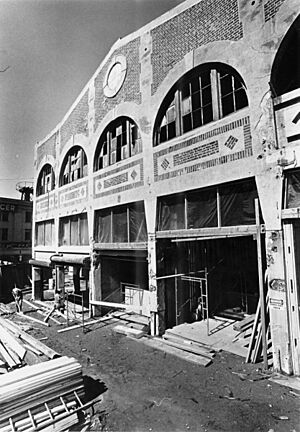
The Pike Place Market, a major tourist spot in Seattle, got its modern look after the Boeing crash. The internment of Japanese Americans during World War II had greatly affected the market, as many vendors were Japanese. In 1971, a "Keep the Market" effort, led by architect Victor Steinbrueck, succeeded in saving and improving the market. Despite opposition, the project was very successful, and today Pike Place Market attracts millions of visitors each year.
A similar story happened with Pioneer Square. This old neighborhood, built after the 1889 fire, had become run-down after the war. But as downtown became more active, businesses looked for cheap buildings to renovate. When offices moved in, new restaurants, galleries, and shops opened to serve them. Seattle was clearly recovering from the Boeing recession.
Starting in the late 1950s, Seattle also became a center for the American counter-culture and protest movements.
High Tech: 1970 Onwards
In 1979, Bill Gates and Paul Allen, who founded Microsoft, moved their small company from New Mexico to the suburbs of their hometown, Seattle. By 1985, Microsoft's sales were over $140 million. By 1995, it was the world's most profitable company, and Gates and Allen were billionaires. Thousands of their employees also became millionaires.
Microsoft led to the creation of many other companies in the Seattle area. Millionaire employees often left to start their own businesses, and Paul Allen became a major investor in new companies. Seattle-area companies like RealNetworks and Amazon owe their start, at least partly, to Microsoft's influence. Unlike Boeing, Microsoft helped create a whole new industry in the area. Microsoft also helped local communities by donating software to schools, including the University of Washington.
Seattle has also seen good growth in biotechnology and coffee. The international coffeeshop chain Starbucks started in Seattle, and the Seattle-based department store Nordstrom is now a national brand.
Paul Allen, who made his fortune from Microsoft, has been a major influence in Seattle. He tried to create a huge park called the Seattle Commons, but voters rejected it. (Allen is now a leader in developing this same area as a biotech center.) He did help get a football stadium for the Seattle Seahawks and founded the Experience Music Project at Seattle Center.
Seattle tried to be a global host by holding the World Trade Organization Ministerial Conference of 1999. However, the city became known for the first major street protests against the World Trade Organization on November 30, 1999. In 2001, there were also riots in the city during the Seattle Mardi Gras riot. Seattle, like other West Coast cities, also saw protests and some violence during May Day marches in 2015.
Today, Seattle looks and feels similar to how it did in the 1960s. It still has many single-family homes, a diverse population, and a progressive outlook. The suburbs have grown, but they are also similar. Seattle's economy is now more active and richer, with more cultural events. Boeing is still a major employer, though its headquarters moved to Chicago. Microsoft and Amazon are now leading tech companies, and many startups have emerged from them. Pioneer Square still has some of its old charm. The city and its natural surroundings are still very beautiful.
Images for kids
-
A newly built Boeing B-29 Superfortress traveling by barge in the Lake Washington Ship Canal in 1944.



